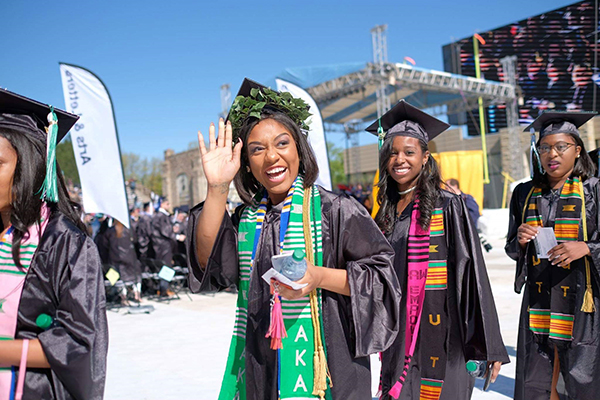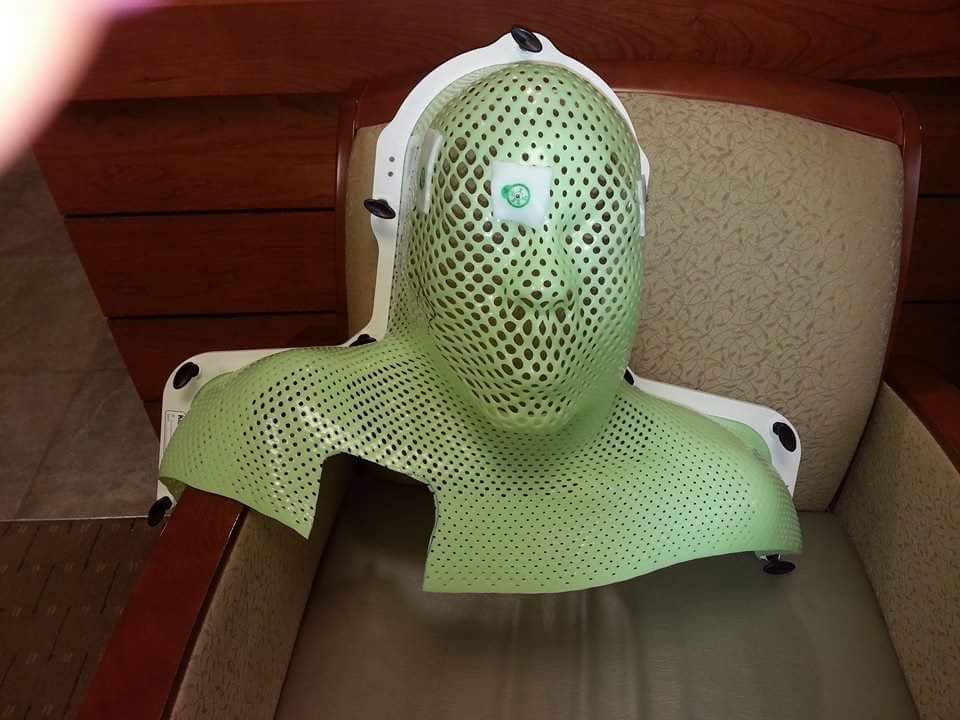A Willful ‘Warrior’
Alumna Sydney Petty confronts cancer unconventionally while attending school
By Laurie B. Davis

Cancer has attacked Petty’s body over a period of three and a half years. By the time she earned her bachelor’s degree, the disease had spread from her nasopharynx to her hip, to her pelvis, her back and her chest. Graduating was a feat many thought she might never accomplish, including herself. While cancer is not uncommon, Petty, who was diagnosed in October 2013, responded to it unconventionally, triggering a long contest of wills between herself and her doctors and parents.
It begins at Stage IV
In late October 2013, Petty, a resident adviser at the time, was chronically tired. One day a lump appeared on her neck. The pain was mild, she says. “I’d had a swollen lymph node under my arm before but it went away, and I thought that’s what it was.” As the lump got bigger and hurt a little more, she decided to see her family doctor.
After a negative test result for a viral cause, her physician suggested a biopsy. At 6 p.m. on Oct. 28, 2013, Sydney and her mother, Clara Petty, were asked to come into the doctor’s office for a conversation. “If you’re getting a call from your doctor at 6 p.m., you already know it’s not good,” says Sydney. They learned then that Sydney had squamous cell carcinoma, a cancer that presents in the head and neck. “I didn’t cry; actually, my mom cried,” says Sydney. “I didn’t know what to say.”
That day marked the beginning of a journey that put the 19-year-old in the uncomfortable position of listening to her own logic about how to attack the disease, while her radiologist and oncologist recommended conventional treatments, and her parents pleaded with her to follow their advice.
Doctors could not remove the tumor surgically, not even after Clara acquired a second opinion at the Cleveland Clinic. “They said they’re not going to touch it; it’s on her jugular vein, it’s too risky,” says Clara. Dr. Steven J. Rubin, an oncology radiologist at Flower Hospital in Toledo, pinpointed nasopharyngeal cancer as the type of squamous cell carcinoma Sydney had. It was Stage IV, and the traditional treatment is chemotherapy and radiation.
“Sydney refused it, and because she was 19, she was able to refuse treatment,” says Clara. “She came home and decided to withdraw from school, and then she began her own personal regimen of how she was going to treat her cancer. She started juicing, she changed her diet, there were all these different therapies she wanted to try,” says Clara.
“They wanted me to get on chemo and radiation, but in my senior year of high school I had gone vegan and I learned a lot about natural medicine,” says Sydney. “I tried natural treatments, but I wasn’t consistent,” says Sydney. “I withdrew the semester that I got diagnosed. I was so into fitness, and I thought, I’ll just be a personal trainer, but I was still into nutrition. I thought I would get a certificate, because I wasn’t sure I wanted to go back to school.”
A breaking point
Sydney’s natural-based treatments continued into December, says Clara. “So now you can’t see the definition between her jawbone and her neck because the tumor was growing.” At a doctor’s appointment, chemo and radiation again were suggested as the way to treat the disease. “She said she wasn’t going to do it. So, I asked them, what is going to happen if she doesn’t do it? We were told that if she doesn’t do anything, the tumor was going to grow into her brain, and she’s going to die. I was in tears, and her dad is in tears. And she said, ‘No, I’m not doing it, it’s going to kill me.’”
Sydney says one of her doctors told her people with nasopharyngeal cancer have a 30- to 40-percent survival rate. Those statistics made her think that the chemo and radiation wouldn’t work. “It’s like knowing the doctors are just keeping me alive as long as they can,” she says.
Clara says, “The defining day was Dec. 14; I remember it clearly.” That day a friend of Clara’s, who was a pharmaceutical sales representative, asked to talk to Sydney about the advancements in chemotherapy drugs that now have fewer side effects. Clara asked Sydney to talk to her friend. “I notice her neck again, and I asked her to come into my bathroom. I literally pushed her face into the mirror, and I said, this is crazy. Look at your neck, we’ve got to do something.”
The friend convinced Sydney. “OK, I’m going to do it,” she told her mother. “Now, Sydney will tell you that I bullied her. That’s her favorite word to tell everybody. I told her, you call it what you want to call it because you’re still here,” Clara says.

Under pressure
Later that month, Sydney experienced a setback. “She came to my room and she could hardly even swallow,” says Clara. “She said, ‘I’m having a hard time, it feels like my throat is trying to close.’” At Clara’s insistence, they went to the ER and Sydney was admitted to Flower Hospital. She stayed for two and a half weeks. “They just didn’t know what to do,” says Clara. Sydney was fed through a feeding tube, which is common for patients who receive radiation to the neck. Clara says it was during that time in the hospital that she saw her daughter cry for the first time because when Sydney touched her neck, the skin fell off.
Even while hospitalized, the treatments continued. “The doctors said Sydney was having a hard time laying on the table. She couldn’t get comfortable,” says Clara. Another biopsy showed the cancer had metastasized and was now in her hip region. “They said, ‘We probably need to do some more chemo and radiation for the hip,’” says Clara. “And Sydney said, ‘I’m not doing it, momma.’”
A trip to Miami followed the last radiation treatment to the neck tumor. The pain in her hip was obvious, as she struggled to walk across the sandy beach. When they returned home, Clara persuaded Sydney to do the radiation on her hip without the chemo. Sydney also began taking online classes at that time, which was summer 2014. “I declared independent studies because we didn’t have a dietetics program here,” says Sydney, about her interest in health and nutrition.
“She decided she wanted to finish school. That was her thing; she wanted her degree,” says Clara. “Before we finished the hip radiation, it had spread to her pelvis. And I thought, dear God, can she just get a break? Can we come here just one time and not get some bad news? Because that has not happened for her in these three years. She decided she was going to do nothing,” Clara adds.
“It was all through 2015 I refused to do chemo because it was horrible the first time,” says Sydney, even though she could feel pressure on her pelvic bone. She was taking classes and taking pain pills to get to her classes. Sydney says she struggled with the idea that chemo and radiation might be the only thing that would keep her alive, but she carried on taking pain pills, going to classes and not getting treatments.
Come to my aid
The next PET scan, says Clara, showed the cancer had traveled to her back. “She went to classes; she was all doped up on Percocet to make it across campus,” says Clara. “She had a special cushion to sit on in her classes. We registered with Student Disability Services, and one thing I can say about The University of Toledo: That disability department is excellent. They really worked with us; they worked with her. They made sure she had everything she needed to get through her classes,” says Clara.
Sydney had to take the Introduction to Public Health class, which prompted her to change her major to that field. “Honestly, I wanted to help people. Public health is about primary, secondary and tertiary care, and I didn’t want anyone to go through this like I did. I wanted to help people learn, especially in the African-American community; the way we eat has been passed down from generations. And I thought I could help reduce their risk of certain kinds of cancers.” At the end of 2015, Sydney declared public health as her major.
Sydney says in 2016, while still going to school, her chest became painful and her breathing was labored. Her mother says she coughed constantly. Another PET scan revealed cancer in her chest, which was putting pressure on her trachea. “Now me and her dad are just frantic, and we were looking for any drug trials,” says Clara.
Last hope and a biologic match

The doctor asked Sydney’s parents if they had asked to have Sydney’s tissue sent to Foundation One a company that tests cancer tissue to find an immunotherapy match. “We don’t know about Foundation One,” Clara told him. “He sent her tissue and it came back with a match for 10 therapies. He said he’d never seen anything like it,” says Clara. The doctor told her the good news that also could have a downside. The treatments could be anywhere, possibly as far away as California. “I said, doctor, I don’t care where it is, I will sell everything I have and we will go.”
Clara says Mowat got access to the immunotherapy drug, Keytruda, to treat Sydney in Toledo. She now gets treatments every three weeks. “I thought we would have to go to Detroit for the therapy, so I bought a new car, because I thought we’d have to go back and forth. I didn’t want anything to get in our way of getting her treatments. We had no more options when it went to her chest. If I had to travel wherever, then that’s what I was going to do,” says Clara.
“After my doctor came back, he said he could do [the immunotherapy treatment] here. He said, ‘I didn’t think you would last this long,’” says Sydney. “The first treatment was horrible. My immune system had a problem with it, and there was a lot of inflammation going on. It was pushing down on my hip. It was the worst pain I’d ever felt in my life.” Sydney stayed in the hospital for a night and made it through her body’s adjustment to the new cancer-fighting drug.
Prayer, faith and free will
In 2014, not long after Sydney’s diagnosis, her godparents flew her and Clara to the International House of Prayer in Kansas City, Mo., where they all prayed for Sydney’s recovery. “We spent two days in constant prayer,” says Clara. “We didn’t know what else to do; it certainly couldn’t hurt. We said, ‘Let’s go petition God, and lay this before him.’” Sydney says the people prayed over her for a prophecy of world travels ahead of her. In the beginning, she says, “I was kind of wary about it.” Now, she has plans for future travel. “I’m going on a cruise this August, and I’m planning to go to Dubai. I’m trying to make this prophecy happen.”
Her faith has wavered throughout her illness, she says, and she strongly believes that personal choices determine outcomes. “I know everybody says everything happens for a reason, but why would God punish me with that? If God is a loving God, why would he punish you? It’s like people bringing back the Old Testament. God isn’t a puppet master. He gave you free will for a reason.”
She wonders if the food choices she’s made, including the traditional southern African-American diet and junk food play a major role in her cancer.
Family genetics also worry her. “You get your parents’ genetics: If your parents ate badly, if they’ve already got high blood pressure, diabetes, cardiovascular disease, if they’ve got all of that going on. It’s going from generation to generation, and all it’s doing is getting worse. My child will have a cell with cancer and will be more prone to cancer.”
‘Anything you need’
Sydney thought school could wait when she first was diagnosed and uncertain of her future, but a strong desire to help others persisted. “I wanted to help prevent people from getting some cancers through diet and exercise. Once I did public health, that lit a fire under me. I wanted to help prevent people from smoking so they don’t get lung cancer, help people eat a healthy diet, especially African Americans to stop eating that junk food. Help people to exercise, to reduce stress.”
Studying and learning her coursework lessons challenged Sydney, but her friends — Amani Brown, Tiara Ward and David Jones — helped her and pushed her forward. “The only way I could survive those semesters is that I studied with my friends Amani, Tiara and David. They would help me study and try to understand. I finished and got a 3.7 that last semester.”In times of trouble, friends often come to the rescue. For Clara, it was her sorority sisters in Alpha Kappa Alpha Inc. who helped in many ways, including financially. “My sorority members would send checks to my house; “anything you need Clare,” they would write. “I know that I made it because of them. Any time [the medical staff] would mix a compound together to try to ease Sydney’s pain, the insurance wouldn’t cover it. I’d say, I’ll pay it; I’ll fight to get my money back later.” In addition to the sorority, the Toledo Chapter of Charms, The Links Inc., and Clara’s church, Walk the Word Ministry, offered support and encouragement.
Keep moving forward
 Sydney’s current goals veer slightly from her original plans, but first and foremost, she says, the main goal is “to live life.” She’s also looking to possibly apply to a perfusion program at Vanderbilt University or in Arizona. As a perfusionist, she would help pump air into the lungs of patients in cardiac surgery. She hopes to keep a flexible schedule this fall as a substitute teacher, so she can be open to travel. She also wants the immunotherapy to end.
Sydney’s current goals veer slightly from her original plans, but first and foremost, she says, the main goal is “to live life.” She’s also looking to possibly apply to a perfusion program at Vanderbilt University or in Arizona. As a perfusionist, she would help pump air into the lungs of patients in cardiac surgery. She hopes to keep a flexible schedule this fall as a substitute teacher, so she can be open to travel. She also wants the immunotherapy to end.
If you ask her what it was like to graduate from The University of Toledo on May 7, 2017, Sydney describes a day full of excitement and meaningful memories. “I didn’t cry,” she says, even as her friends and family members cheered her on, raising signs with her face affixed to them and yelling her name. “Then I thought, oh, my gosh, I’m really doing this.” Tears emerge as she recalls the day. “I’m proud to be a 2017 graduate. Even though I missed a year, it shows that I kept going. I never knew each day how I’d be the next. I didn’t even know at one point if I wanted to come back. But I was there, crossing the stage and getting my degree.”
Clara accepts her daughter’s decisions and even credits them for getting her as far as she’s come through this unforgiving disease. “I do not believe, in my heart of hearts, that my child would be here today if it was left up to me and her dad because we would have done everything [the doctors] told us to do. And I believe that because she didn’t do some of those things, and she put her foot down and said I’m doing this my way. She’s going to be 23 at the end of July, and when she was 20, she came to me and said, ‘I’m not going to live my life being sick to only die anyway.’ She has lived her life like she’s not sick. And I think that’s why Sydney is still here.”
She believes that taking a year off from doing chemotherapy directed her path toward discovering immunotherapy. Two scans have shown that the immunotherapy treatments are decreasing Sydney’s cancer.
Sydney has never been in remission since cancer invaded her body nearly four years ago. She says she now combines natural remedies with medical treatments. She doesn’t see herself as a special case. “Everyone is always saying, ‘You’re so strong.’ Anybody in this situation would be as strong because you don’t have a choice. I had so much support,” she says.
But Clara commends her daughter for having beaten the odds, so far, describing Sydney’s fortitude probably better than anyone: “My child is a warrior.”







